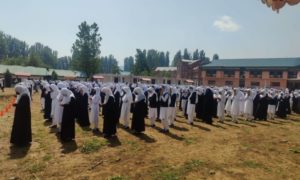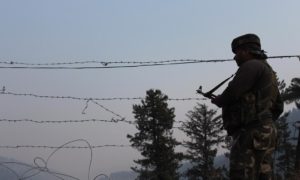Fact-finders at the Srinagar-based rights body JKCCS understood at the very beginning that compiling a report on torture in Kashmir was akin to scratching old wounds. Scars indeed bled afresh when they hit the field and returned home with haunting horrors.
Prodded first by the title itself, the cover page of the recently released report on Torture – the Indian State’s Instrument of Control in Jammu and Kashmir, is even more of a jolt.
The first half of the image has a number of weapons lined up in succession – knives of varying lengths, cleavers and a two-pronged fork among others. Below, the right-profiled mugshot of a wrinkle-faced, bespectacled man: Mohammad Qalander Khatana.
Khatana was arrested by Indian armed forces’ Border Security Force (BSF) personnel in 1992 and taken to various camps across the region, put through increasing levels of inhumane torture, that finally culminated at his stint in the infamous PAPA 2 torture center. Made to “eat his own flesh”, wounds left for maggots to feast on, Khatana eventually had his legs amputated.
His case study, and those of 431 other victims of torture, constitutes the chillingly detailed report—compiled by the Jammu and Kashmir Association of Parents of Disappeared Persons and the J&K Coalition of Civil Society—which recently evoked a stern response from Nilz Melzer, the United Nations Special Rapporteur on torture. Melzer noted the human rights violations reported were ‘very grave’.

The cover of the report.
For the past twenty-odd years that the organisation has been functional, JKCCS has worked on numerous issues, modern-day phenomenon and individual narratives, producing an equally varied body of reports and articles. Why then the need to produce one comprehensive report, spanning across 550 pages on the phenomenon of Torture?
“Because Torture is hardly reported,” says Shazia Ahad, a researcher with JKCCS who was part of the team working on the said report.
According to Shazia, Torture is arguably the most pervasive of all human rights violations, affecting all possible facets of human life and one that sees the most number of victims. Yet, it’s one of the most underrated ones.
“Torture is reported only in association with some other violation, be it forced disappearance, attempted murder or custodial death,” she explains.
Replicating the starting points of earlier reports at JKCCS, the report on Torture started with people either calling in or dropping in office to narrate their accounts of torture, according to Parvez Imroz, President, JKCCS.
“The intention was to compile them all first and give them shape and verify them,” he says.
Though no stranger to the reality of violence around her, Shazia fell just short of being normalised to it. For her, the trauma and suffering, even for those who aren’t victims, simply builds up over time.
“You can get used to cordon and search operations being a frequent thing, but not the individual instances of violence. It’ll always affect you,” says Shazia, for whom the tipping point was the increased advent of reported torture, killings and violence of the 2016 street upheaval in Kashmir.
“I simply had to do something about it,” she affirms.

When Shazia joined the organisation, efforts to compile a report in place were already midway. Though she started off with assisting in data entry, she was soon involved in the ongoing on-ground efforts as well.
As is common with anyone who’d decide to dive right into assignments of this nature, Shazia found it difficult initially coping up with the realities of the victims and the use of torture in the Valley – despite being a native. This again, she credits to torture not being talked about enough.
“I would get nightmares initially after reading about cases of torture,” she recollects.
But after a period of time, she says the naturally occurring survival instinct in humans put an end to her nightmares. “That was the only reason why I could work on this for two years, preserving my sanity,” says Shazia.
Though members of the team working on the report were not formally trained to grapple with the onslaught of stress and trauma the work could possibly bring to them, they had each other to fall back on.
Members were encouraged to meet up constantly in the course of the research, to discuss ideas, challenges on the field and refine the blueprint from time to time.
“We had one another to talk to, professionally and personally. Knowing that we were all in this together, helped,” says Shazia.
According to the report, an overwhelming number of torture victims are civilians. About 27 of the documented individuals have approached the State Human Rights Commission, with an even dismal number finally fetching something fruitful out of the exercise.
But for someone who prima facie professed utter distrust in the state mechanism and any such institution per say, how difficult was it to get them talking to the researchers?
“It takes time,” says Shazia.
A constant remark from the victims, was, “Phir Kya Hoga (What will change)?” says Imroz.
Though this was also one of the pointers discussed upon amongst team members, it takes some time for them to settle down with the victims and their families and to explain and convince them of the motive behind compiling a report.
“We told them that their stories are history that should not go unreported, or lost. We need to document them,” Shazia continues. “So we had to ensure the victims were not given any sort of false hopes in the process.”
The convincing, however, did not necessarily work all the time, as some victims never spoke of their trauma.

Parvez Imroz.
Such response was natural, Shazia says, as talking to individuals about their suffering means pushing them to relive the horrors all over again.
When asked whether this seemed doubly invasive, she quickly replies that it takes belief in one’s own intentions in doing so.
“You need to be convinced of your motive,” she says. “People do relive their traumas, but then if we don’t talk about it, our present is going to continue in darkness.”
But the researchers had little apart from the victim’s testimony to document torture. For example, in the event that a victim was medically treated while in detention, all medical reports and records were taken away at the time of release.
Even if the individuals did seek medical help once released, those records were not preserved either. To serve the purpose best then, the researchers for most part of their interactions with the victims and their families let the latter speak their hearts out – sometimes even beyond the purview of the questionnaire.
“We didn’t want to interfere mid-conversation and contaminate or dilute their memories,” Shazia says.
The team did at times have to ask pointed questions since the victims would particularly hesitate or vaguely discuss instances of sexual torture.
Though some of the names of the interviewees are withheld, what’s surprising is to see some of their names printed in black and white. Placing oneself in their shoes actually makes you wonder why they’d even consent to their identities being revealed, inspite of having the choice of their names being withheld.
“Some of them simply don’t see themselves as being eligible for detention and torture again,” explains Shazia.
Similarly, victims of recent torture have their names withheld in the report, owing to a well-placed fear of still being under the scanner.

Illustration by Mir Suhail used in the report.
Going through the report, in the very first bunch of pages itself when the detailed case studies have just begun, you cannot escape but notice the systematic apathy present in such situations.
Similarly, as the report observes as well, counterinsurgency warfare was developed in a colonial context. It continues till date.
“For example, even the Armed Forces (Special Powers) Act is colonial, but a lot more vigorous now in fact,” notes Shazia.
Such laws, she says, do nothing much beyond helping the State in shielding its armed personnel, at the cost of the track of record of human rights sliding downhill. Come what may, she asserts, no personnel across the command chain has been held accountable. “Neither a prosecution nor a trial in a civil court, has taken place against an armed forces personnel. This impunity gives them, as is said, a ‘free hand’.”
Such kind of all-percolating non-liability did hinder research efforts, in some way or the other.
For example, Shazia says, some victims simply refused to converse with the researchers, for the fear of being further repressed by the government. At times, even the volunteers from the local communities who were instrumental in facilitating the on-ground work, backed out last minute for their hesitation to be publicly associated with a human rights organisation.
“Credibility is something that you build brick by brick,” says Imroz when asked about how a humanitarian organisation itself thrives under the ‘scanner’. “You cannot give anyone the opportunity to silence you.”
Torture, Shazia says is a tool, seldom used to punish an individual, but entire populations and bring them to submission.
“Torture is used to send out a message – this is what we can do to you, if you do not listen to us or do what we want you to,” she says.
However, the use of torture is often credited with being imperative in serving larger State objectives in the face of insurgency.
“We’ve had a victim telling us that water-boarding was in fact easier than everything else he was put through,” Shazia says. “Every torture method that there possibly exists has been used. They may vary in intensity but not in novelty.”
Though torture in itself is an illegal practice, what’s unacceptable however is the blurred line between what defines a civilian and a militant, under such situations. “For that matter the entire state is a militant ‘sympathiser’. That’s how we’re being treated,” she says.

But now that the report is out, JKCCS aims at replicating the impact they got with their previous reports, prominent amongst them being the one on Mass Graves in Kashmir. The issue found presence in mainstream dialogue and as a result, became global discourse.
“When you work on something of this nature, you get through many difficulties – personally and professionally. When it’s finally ready for release, that’s satisfying,” Shazia says.
According to Imroz, JKCCS has been getting calls from victims post the release of the report, sharing worse accounts of torture with the rights body.
However, the seemingly underwhelming media attention to the report has not necessarily left the researchers disappointed.
“Media attention internationally has been good, but though we did not expect mainstream media to carry the news, some major outlets in Kashmir did not as well,” Shazia says.
Humanitarian organisations seldom have the support of the media, as opposed to other places where they support you, Imroz says.
The response from other humanitarian organisations across the globe has only proved catalytic to the cause the JKCCS Report aims to serve.
The Asian Federation Against Involuntary Disappearances based out of Philippines promoted the Torture report in a formal statement, observing that it understands ‘the close relationship between arbitrary detention, torture and enforced disappearances’.
Similarly The Asian Forum for Human Rights and Development condemned the use of inhumane and degrading use of torture in Kashmir by law enforcement agencies.
“We can engage international media and institutions to seek moral accountability from the Indian Government,” says Imroz.
At the same time, JKCCS isn’t overambitious – the least they hope for, is for the phenomenon of torture to be minimised, if not completely stopped.
The organisation has reportedly been informed of police agencies visiting the homes of the victims and verifying the details.
Importantly, efforts such as the comprehensive report on Torture are to ensure accountability for human rights violations in the post-conflict scenario as well.
“The ordinary person cannot fight back,” Imroz says. “But conscious sections of society can.”
Like this story? Producing quality journalism costs. Make a Donation & help keep our work going.










